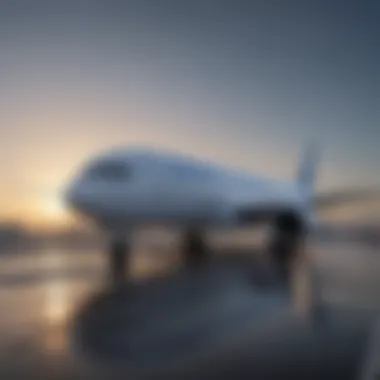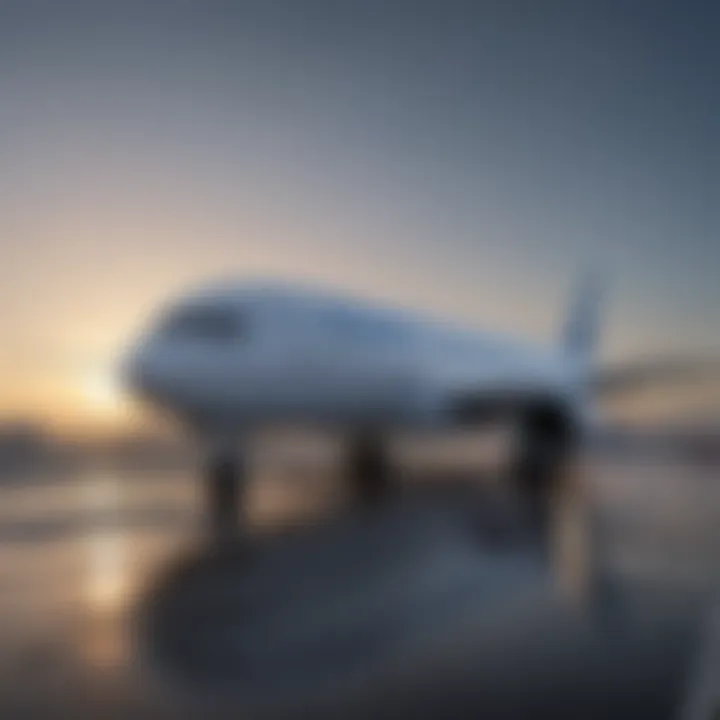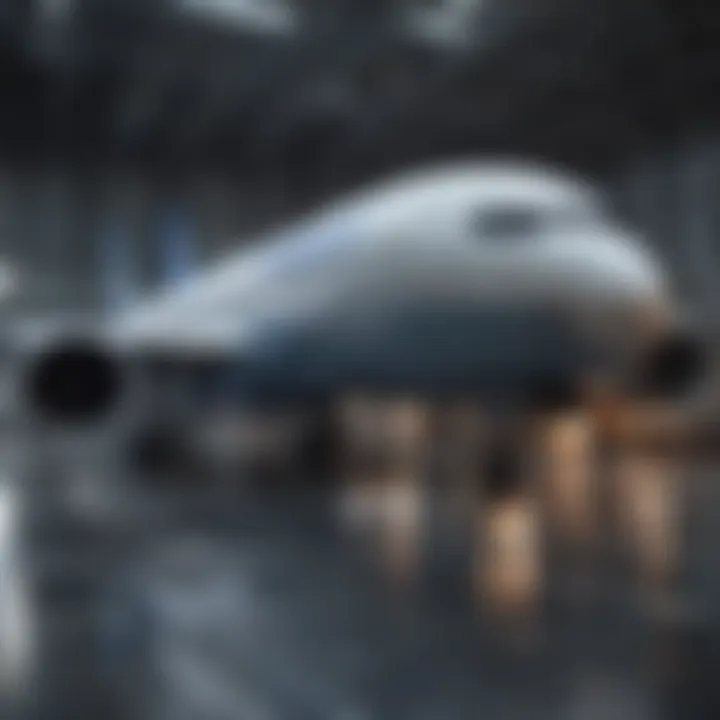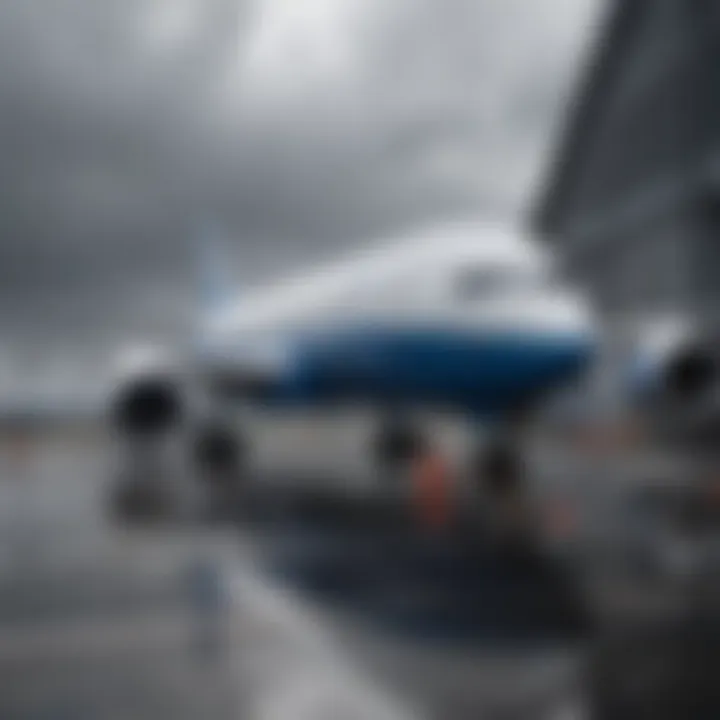Exploring the Boeing 787 Dreamliner: Innovations and Impact


Intro
The Boeing 787 Dreamliner represents a significant advancement in aviation technology. This aircraft was designed to maximize passenger comfort while enhancing operational efficiencies. Its introduction has altered the landscape of commercial aviation, influencing various aspects such as fuel consumption and environmental sustainability.
The 787 is crafted with a focus on long-haul travel. It incorporates advanced materials and systems to improve performance and reduce the overall weight of the aircraft. Understanding the intricacies of its design and engineering helps shed light on how this aircraft has redefined expectations in the sector.
Moreover, the environmental impact of the Dreamliner cannot be overstated. The inclusion of modern engines and improved aerodynamics contribute to its reputation as a more eco-friendly choice compared to previous generations of aircraft. The significance of the 787 Dreamliner goes beyond merely being another commercial jet; it is a symbol of innovation and forward-thinking in an industry that continuously strives for improvement.
In the following sections, we will explore the key findings related to the 787 Dreamliner, delving into the methodologies involved in its design and how data was collected and analyzed during its development. This comprehensive examination aims to inform enthusiasts, scholars, and professionals alike about the nuances surrounding this aircraft.
Preamble to the Dreamliner
The Boeing 787 Dreamliner represents a pivotal moment in the evolution of modern aviation. This aircraft is not merely a mode of transport; it embodies the culmination of advanced engineering, innovative design, and a commitment to sustainability. Understanding the significance of the 787 requires a closer look at its background and the notable advancements it introduces to the industry. The introduction of this aircraft marks a significant turning point, showcasing how technological progress can improve passenger experience and operational efficiency.
Background and Development
The development of the Boeing 787 Dreamliner commenced in the early 2000s, initiated by the strategic need for a versatile aircraft capable of connecting smaller cities with greater efficiency. Boeing aimed to create an aircraft that would not only reduce fuel consumption but also improve passenger comfort. After several years of research, design, and collaboration with various suppliers, the aircraft took its maiden flight in December 2009. The innovative use of composite materials allowed for significant weight reductions, resulting in improved fuel efficiency and reduced environmental impact. Moreover, its unique design features prominent a larger wingspan, which is largely responsible for its aerodynamic performance.
Significance in Aviation History
The 787 Dreamliner stands as a landmark in aviation history for many reasons. First, it represents a shift toward more sustainable air travel by significantly reducing carbon emissions and noise pollution compared to older aircraft models. The introduction of the 787 has not only influenced Boeing's market positioning but has also prompted competitors to rethink their own aircraft designs. The Dreamliner has become a symbol of advancement in aviation technology and a practical solution to global environmental challenges.
"The 787 Dreamliner is not just another aircraft; it is a statement in operational efficiency and eco-friendliness, setting standards for future generations of air travel."
Design and Materials
The design and materials of the Boeing 787 Dreamliner are crucial to its performance, sustainability, and passenger experience. This aircraft exemplifies modern engineering practices, showcasing how innovative materials and designs can achieve remarkable efficiency and comfort in aviation. A deeper understanding of these aspects is vital for anyone engaged in the field of aerospace and related industries. The integration of advanced materials not only enhances the performance metrics of the aircraft but also addresses some of the pressing environmental challenges faced by aviation today.
Composite Materials Use
Composite materials play a significant role in the construction of the Boeing 787 Dreamliner. Approximately 50% of the airframe is made of composites, which include carbon fiber reinforced polymers. These materials offer several advantages over traditional aluminum structures. First, composites are lighter, allowing for reduced weight without sacrificing strength or durability. This reduction in weight directly contributes to improved fuel efficiency.
The use of such materials also enhances the aircraft's resistance to corrosion, increasing longevity and reducing maintenance costs. Furthermore, the ability to mold composites into complex shapes aids in aerodynamic efficiency, aligning with the overall performance goals of the 787.
"The 787 Dreamliner’s extensive use of composite materials signifies a shift in aviation design, addressing both performance and environmental goals."
However, the introduction of composite materials is not without its challenges. Manufacturing these components involves sophisticated techniques, and quality control requires rigorous standards. Each element must be tested thoroughly to ensure it meets safety regulations and performance expectations.
Aerodynamic Innovations
Aerodynamics are critical to the efficiency of commercial aircraft, and the 787 Dreamliner incorporates several innovations that enhance its aerodynamic properties. The design features a sleek fuselage shape, extending the aerodynamic profile. This not only reduces drag but also improves overall fuel efficiency.
The wing design also reflects advances in aerodynamics. The wings of the 787 are larger and feature raked wingtips, which contribute to improved lift and reduced drag. This configuration allows the aircraft to cruise at higher altitudes and speeds without incurring significant penalties in fuel consumption.
The incorporation of advanced wing designs conveys how aerodynamic considerations are interwoven with material choices. The ability of composite materials to withstand the stresses encountered at high altitudes enables these aerodynamic features to function effectively.
Cabin Configuration
The layout and features of the aircraft cabin significantly influence the overall passenger experience. Cabin configuration in the Boeing 787 Dreamliner is particularly important as it emphasizes passenger comfort and utilizes innovative designs to enhance the travel experience. This section will discuss various aspects, such as passenger comfort features and technological enhancements in the cabin. Together, these elements demonstrate a significant step forward in aircraft design compared to previous generations.
Passenger Comfort Features
Boeing has made substantial efforts to improve passenger comfort in the 787 Dreamliner. The aircraft incorporates several key features aimed at enhancing the flying experience. Among these features, one notable aspect is the cabin altitude. The 787 operates at a lower cabin altitude of 6,500 feet, compared to the typical 8,000 feet in most aircraft. This reduces the likelihood of discomfort and fatigue during long flights.
Additionally, the humidity levels in the cabin are higher, contributing to an overall more pleasant environment. Passengers often report feeling fresher and less dehydrated. The spacious cabin design allows for wider seats and ample legroom, which further enhances comfort. Boeing also designed larger windows that not only provide better natural light but also feature electronic dimming technology, allowing passengers to control the brightness according to their preference.
Key Features of Passenger Comfort:
- Lower cabin altitude at 6,500 feet.
- Higher humidity levels for reduced dehydration.
- Wider seats and more legroom.
- Larger, electronically dimmable windows.
Overall, these comfort features work together to create a more enjoyable flying experience for passengers, making the 787 an attractive option for airlines seeking to enhance their service.


Technological Enhancements in Cabins
In the spirit of innovation, the Boeing 787 Dreamliner also integrates advanced technologies within its cabins. These enhancements extend beyond just comfort and play a critical role in operational efficiency and passenger convenience. One of the most significant advancements is the incorporation of a state-of-the-art cabin management system, allowing for more intuitive control of lighting, temperature, and in-flight entertainment.
Furthermore, onboard connectivity options have improved dramatically. Many airlines operating 787s now offer Wi-Fi access, enabling passengers to stay connected while in the air, catering to the needs of travelers expecting modern conveniences. The entertainment system is designed with high-definition displays and a wide variety of content, providing an engaging experience during the flight.
Technological Features Include:
- Advanced cabin management system for better control.
- In-flight Wi-Fi connectivity.
- High-definition media displays with diverse content.
These technological enhancements contribute to a modern flight experience and address passenger expectations for seamless connectivity and functionality during their travels.
The Boeing 787 Dreamliner illustrates a commitment to redefining passenger experience through innovative cabin configurations and advanced technologies.
Performance Metrics
The performance metrics of the Boeing 787 Dreamliner are essential in evaluating its capabilities and advantages in modern aviation. Understanding these metrics provides insights into how the aircraft functions in terms of efficiency and operational effectiveness. The main elements that contribute to performance metrics include fuel efficiency, range, and payload capacity. These factors are critical not only for airlines looking to maximize profitability but also for addressing environmental concerns associated with air travel. Hence, the examination of these metrics reveals the impact of the Dreamliner on both the industry and society.
Fuel Efficiency
One of the standout features of the Boeing 787 Dreamliner is its exceptional fuel efficiency. This aircraft employs advanced aerodynamic designs and state-of-the-art engine technology, specifically the Rolls-Royce Trent 1000 and General Electric GEnx engines. These engines are optimized to reduce fuel consumption while maintaining optimal performance. The use of composite materials, which constitute about 50% of the airframe, contributes to overall weight reduction. As a result, the Dreamliner can achieve up to 20% lower fuel burn compared to similar-sized aircraft.
Moreover, the reduction in fuel consumption directly impacts operating costs for airlines. By lowering fuel expenses, airlines can allocate resources to enhance other operational aspects, thereby improving profitability. In a climate where fuel prices can fluctuate widely, having an aircraft that manages fuel efficiently is a considerable advantage.
Thus, the fuel efficiency metrics of the 787 are vital indicators that not only shape the aircraft's operational policies but also frame its position in an increasingly cost-conscious market.
Range and Payload Capacity
The range and payload capacity of the Boeing 787 also reflect its design philosophy and operational goals. The 787-8 model has a maximum range of approximately 7,530 nautical miles, while the 787-9 extends that range to about 7,530 nautical miles as well. This long-range capability allows airlines to operate non-stop flights on many routes that were previously unfeasible. It connects distant markets while also providing airlines with the flexibility to adjust their operations based on demand.
Furthermore, the Dreamliner has an impressive maximum payload capacity. The 787-8 can accommodate roughly 242 passengers in a typical two-class configuration, while the 787-9 can hold up to 290 passengers. Such configurations enable airlines to adapt their offerings based on various routes, optimizing earnings potential.
The interplay between range and payload capacity has direct implications for market strategies. Airlines can serve new markets and enhance their network efficiency without necessarily increasing costs on older aircraft.
Technological Advancements
The technological advancements in the Boeing 787 Dreamliner represent a crucial aspect of its contribution to modern aviation. Innovations in design and engineering not only enhance the aircraft’s performance but also improve overall operational efficiency. This section explores two major components of these advancements: flight control systems and avionics enhancements.
Flight Control Systems
The flight control systems of the 787 are sophisticated and reflect state-of-the-art technology in aviation. The use of fly-by-wire systems allows for precise handling and reduces pilot workload during various phases of flight. This technology replaces traditional mechanical flight controls with electronic interfaces. The result is a more responsive and stable flying experience.
Some key features include:
- Enhanced Stability: The system continuously monitors aircraft performance and makes adjustments automatically. This ensures a smoother flight, particularly during turbulence.
- Safety Protocols: Advanced algorithms help to prevent pilot errors by offering real-time feedback on optimal maneuvers.
- Reduced Weight: Eliminating heavy mechanical components contributes to overall weight savings, improving fuel efficiency.
"The introduction of fly-by-wire technology in the 787 exemplifies how modern engineering transforms flight safety and efficiency."
Avionics Enhancements
Avionics in the 787 Dreamliner consist of cutting-edge systems that improve navigation, communication, and overall operational capabilities. The integration of advanced avionics enhances situational awareness for pilots, helping them make better-informed decisions.
Highlights of these enhancements include:
- Advanced Navigation Systems: Using Global Positioning System (GPS) technology and other aids, the aircraft can navigate with exceptional accuracy.
- Better Communication Tools: Enhanced communication interfaces allow for seamless interaction between the flight crew and air traffic control, reducing the chances of miscommunication.
- Human-Machine Interface: The cockpit features modern displays that present flight data in a user-friendly format, letting pilots focus on critical information effectively.
The convergence of these technological advancements significantly boosts the 787’s performance while focusing on safety and efficiency in operations. Overall, the innovative contributions of the 787 Dreamliner set new standards in aviation technology and inspire future developments in the industry.
Environmental Considerations
The topic of environmental considerations in aviation has gained significant relevance as the industry confronts the pressing concerns of climate change and sustainability. The Boeing 787 Dreamliner has emerged as a notable example of how modern aircraft can address these environmental challenges. This section dissects the specific aspects of environmental impact, particularly focusing on carbon emissions and noise pollution, both critical factors affecting airline operations and community relations.
Reduction of Carbon Emissions


One of the standout features of the Boeing 787 Dreamliner is its emphasis on reducing carbon emissions. The aircraft accomplishes this primarily through its advanced composite materials and efficient engines.
The use of composite materials like carbon-fiber-reinforced polymer significantly lowers the overall weight of the aircraft. This reduction in weight leads to improved fuel efficiency, as lighter planes require less fuel. According to studies, the 787 can reduce fuel consumption by up to 20% compared to similarly sized aircraft. This remarkable efficiency translates into reduced carbon emissions, making the aircraft a more environmentally friendly option for airlines.
Furthermore, the engines of the 787, specifically the Rolls-Royce Trent 1000 and the General Electric GEnx, are designed to emit fewer greenhouse gases. These engines incorporate innovative technologies that enhance combustion efficiency and reduce fuel burn.
Overall, the shift towards these greener technologies not only meets regulatory standards but also aligns with the broader objectives of reducing aviation’s carbon footprint, demonstrating a commitment towards environmentally sustainable flying.
Noise Pollution Mitigation
Noise pollution is another significant environmental issue facing the aviation industry. The Boeing 787 Dreamliner addresses this challenge through various design features and technological advancements that minimize noise levels both within the cabin and during takeoff and landing.
Utilizing quieter engines, the 787 exemplifies a shift towards a more silent operational profile. This is crucial for communities located near airports, as reduced noise pollution can lead to fewer disturbances and an overall better quality of life for residents. Recent advancements in engine technology, such as the use of acoustic liners, further contribute to noise reduction.
Additionally, the aerodynamics of the 787 are refined to enhance its noise performance. The wing design, featuring raked wingtips, not only improves fuel efficiency but also reduces drag, which in turn diminishes engine noise during flight.
By focusing on noise reduction technologies, Boeing has set a benchmark for future aircraft, contributing positively to public acceptance and environmental standards in aviation.
These environmental considerations highlight the strategic approach of the 787 Dreamliner in addressing the dual challenges of carbon emissions and noise pollution in an era where sustainability is paramount. The steps taken by Boeing represent a meaningful contribution to the future of aviation, balancing operational efficiency with environmental responsibility.
Challenges in Production
The development and production of the Boeing 787 Dreamliner present numerous challenges that are critical to understand. These issues not only impact the manufacturing process but also influence the aircraft's entry into service, operational costs, and overall reliability. Addressing these challenges is essential for Boeing to maintain its competitive edge in the aviation market and to ensure the success of the Dreamliner program.
Supply Chain Issues
One of the most prominent challenges affecting the 787 Dreamliner is the intricacies of its supply chain. Boeing opted for a global supply strategy, partnering with numerous suppliers from different regions. While this approach allows for the integration of advanced technologies and specialized skills, it also leads to several complications. For instance, disruptions from a specific supplier can halt production entirely, leading to costly delays and increased pressure on the remaining suppliers to meet the schedule.
In the early phases of production, Boeing faced significant setbacks due to issues with key suppliers. The company had to grapple with parts shortages that impeded the assembly lines. The Just-In-Time inventory model, meant to reduce warehousing costs, became a liability when suppliers could not deliver components as promised. Such misalignments not only affect timelines but also impact quality control. A complex global supply chain increases the touchpoints where issues can arise, ultimately leading to rework and inspections that further delay delivery.
Regulatory Hurdles
In addition to supply chain challenges, regulatory hurdles present another significant barrier during the production of the Dreamliner. The aviation industry is one of the most regulated sectors, with safety being the utmost priority. The Federal Aviation Administration (FAA) and international regulatory bodies impose rigorous standards that Boeing must adhere to throughout the design and production phases.
Meeting these regulations adds several layers of complexity to the production process. For example, the FAA requires comprehensive testing and documentation for each component and system before they can receive certification. Delays in obtaining approval from regulators can stall production and complicate the project timeline. Consequently, Boeing has to invest substantial resources into compliance, which can slow down innovative processes and increase operational costs.
The interplay between supply chain issues and regulatory hurdles has required Boeing to implement better risk management strategies. Understanding the systemic challenges and maintaining close relationships with suppliers can alleviate some issues, but the path forward remains fraught with difficulty.
"Production challenges faced by the Boeing 787 highlighted the vulnerabilities within an interconnected global supply chain, illustrating the need for robust contingency planning."
Market Position
The market position of the Boeing 787 Dreamliner plays a crucial role in understanding its impact and relevance in modern aviation. The Dreamliner has not only changed the market dynamics of commercial aircraft but also set new standards for efficiency and innovation. Its introduction marked a significant shift in airline strategies and customer preferences, making it a vital topic for analysis in this article.
Competitive Landscape
The competitive landscape for the 787 Dreamliner is shaped by several key players in the aviation sector. Major competitors like the Airbus A350 have entered the market with their own innovations, offering similar advantages in terms of fuel efficiency and passenger comfort. The performance of the 787 against these competitors highlights important factors such as production costs, delivery timelines, and capacity.
Airlines often deliberate between the 787 and its rivals based on factors including:
- Operational Efficiency: Airlines seek aircraft that minimize fuel consumption and maintenance costs. The 787 excels in this area due to its lightweight composite materials and advanced aerodynamics.
- Passenger Experience: Comfort is a priority in selecting aircraft. The 787 provides larger windows, improved cabin pressure, and better humidity levels, setting it apart in passenger satisfaction surveys.
- Availability and Support: Timely deliveries and comprehensive support services are crucial for airlines. Boeing has focused on improving turnaround times and enhancing customer support to maintain its competitive edge.
This competitive environment pushes manufacturers to continuously innovate, driving the aviation industry towards more efficient solutions.
Customer Base and Adoption Rates
The customer base for the 787 Dreamliner spans a diverse array of airlines, from established international carriers to emerging regional players. Adoption rates have steadily increased since its first delivery in 2011. As of now, over sixty airlines globally operate the Dreamliner in their fleets, indicating strong market acceptance.
Factors driving the adoption include:
- Enhanced Capacity: The 787 comes in two main variants, the 787-8 and 787-9, allowing airlines to choose based on their operational needs and routes.
- Strategic Alliances: Many airlines have leveraged the technological advancements of the 787 by forming alliances and obtaining favorable financing options. This collaboration often leads to streamlined fleet management and reduced operational costs.
- Global Expansion: As airline networks expand internationally, the need for long-haul, fuel-efficient planes has become critical. The 787 is often chosen for routes that require such capabilities.


"The Boeing 787 Dreamliner has not just transformed airlines' operational frameworks but has also reshaped passenger expectations."
In summary, the market position of the 787 Dreamliner is noteworthy, marked by its competitive advantages and widespread adoption. Understanding these dynamics is crucial for appreciating the aircraft's significance in today's aviation landscape.
Impact on Global Aviation
The introduction of the Boeing 787 Dreamliner has marked a significant turning point in global aviation. Its advanced design and engineering qualities set it apart from previous aircraft. The impact on airline operations, environmental considerations, and passenger expectations is profound.
Market Disruption
The market disruption caused by the 787 Dreamliner is notable. This aircraft introduced new standards and operational efficiencies that competitors are now expected to meet. The 787 has prompted other manufacturers, like Airbus and Bombardier, to innovate and adapt their designs.
Airlines that adopted the 787 have experienced significant reductions in operational costs thanks to its fuel efficiency. For instance, with composite materials accounting for 50% of the aircraft's structure, the weight reduction leads directly to lower fuel burn. This ability to fly longer distances with less fuel alters the routes that airlines can realistically serve.
Companies like All Nippon Airways and Qatar Airways were among the first to implement the 787 into their fleets, allowing them to pioneer new long-haul routes. This change forces legacy carriers to reassess their strategies, influencing fare structures and route planning. A notable example is the introduction of non-stop flights from cities that previously required layovers, enhancing competition on international routes.
The 787 Dreamliner reshaped expectations in both operational and customer-facing dimensions of air travel.
Influence on Airline Strategies
The influence of the 787 Dreamliner on airline strategies is substantial. The focus on fuel efficiency drives airlines to re-evaluate their entire business models. With lower operating costs, carriers can offer more competitive pricing while maintaining profitability. This strategic shift has also seen airlines increasing their use of the 787 in regional markets, which traditionally might not support larger aircraft.
In addition, the enhancements in passenger experience make the 787 appealing to consumers. Airlines leverage this to improve brand loyalty, emphasizing comfort and technology in their marketing campaigns. The introduction of features like larger windows, improved air quality, and quiet cabin conditions attracts a modern traveler demographic.
The operational flexibility provided by the 787 allows airlines to balance their fleets effectively. Focusing on these advanced capabilities encourages airlines to diversify their offerings, ultimately influencing how businesses approach global competition in the airline industry. Airlines are not just competing on price anymore; they are also focusing on sustainable practices and passenger experiences as critical business strategies.
In summary, the impact of the 787 extends beyond individual airlines. It challenges the entire aviation industry to innovate and respond to the evolving market landscape.
Future of the Program
The future of the 787 program is crucial as it plays a significant role in determining Boeing's long-term position in the aviation industry. The program demonstrates how innovation and market adaptability can shape the aircraft manufacturing landscape. As competitors develop their own advanced aircraft, it is essential for Boeing to focus on maintaining its competitive edge through continuous improvement and strategic planning.
Upcoming Variants and Innovations
The next step in the evolution of the 787 series involves the introduction of new variants and additional innovations. Boeing is exploring options for enhancing the existing models, such as the 787-8, 787-9, and the latest, the 787-10. Each variant presents unique advantages in terms of passenger capacity and range. This ongoing development signals Boeing's commitment to meeting the diverse needs of airlines worldwide.
In addition to variants, Boeing is also examining the incorporation of cutting-edge technology. For instance, advancements in aerodynamics and composite materials could lead to more fuel-efficient models with extended ranges. Technologies such as improved wing designs and new engine efficiencies remain at the forefront of this innovation effort.
Long-term Sustainability Initiatives
Boeing's focus on long-term sustainability initiatives reflects an industry-wide push toward environmentally responsible aviation. One of the primary goals of the 787 program is to reduce carbon emissions. Boeing aims to achieve this by utilizing more efficient materials and implementing alternative fuel sources.
Furthermore, partnering with various stakeholders, including airlines and governments, is vital for advancing these initiatives. These collaborations can create pathways for developing sustainable aviation fuels, which will be essential for achieving lower emissions in the long run. Strategies also include enhancing production techniques with a focus on minimizing waste and energy consumption during the manufacturing process.
Sustainability is not just a trend; it is becoming an expectation. The ongoing commitment to environmental stewardship will likely influence future purchasing decisions from airlines, making it a critical component for Boeing's success and relevance in the aviation market.
"The future of the 787 program represents an ambitious blend of innovation, sustainability, and market competitiveness, cementing Boeing's role in the aviation industry's transformative changes."
End
The conclusion serves as a critical culmination of the insights offered throughout the article. It synthesizes the unique elements that define the Boeing 787 Dreamliner and reflects on its significance from various perspectives, including engineering, economics, and environmental stewardship. This section clarifies the important role of the Dreamliner in shaping modern aviation and posits its implications for the future of air travel.
Summary of Key Insights
The research and analysis presented delivers profound insights into multiple facets of the Boeing 787 Dreamliner. Key points include:
- Innovative Design: The extensive use of composite materials has significantly reduced weight, enhancing fuel efficiency.
- Advanced Technologies: Innovations in avionics and flight control systems elevate the operational capabilities of the aircraft.
- Environmental Impact: By minimizing both carbon emissions and noise pollution, the Dreamliner marks a shift towards more sustainable practices in aviation.
- Market Influence: Its entry into the commercial aviation sphere disrupted traditional market dynamics, influencing airline routes and strategies.
- Production Challenges: Ongoing supply chain complexities and regulatory requirements continue to challenge the production timeline and costs.
This comprehensive analysis highlights how the 787 Dreamliner embodies modern aerospace engineering, pushing boundaries that redefine travel standards for comfort, efficiency, and sustainability.
Final Thoughts on the Dreamliner
In summation, the Boeing 787 Dreamliner does not merely represent an aircraft; it exemplifies a trend towards innovation in the aerospace sector. Its integration of new technologies and materials stands as a benchmark for future aircraft designs, making it a pivotal player in the journey towards sustainability in air travel. As the aviation industry evolves, the 787’s influence will likely inspire subsequent innovations, aligning with global efforts to produce cleaner and more efficient aircraft.
Ultimately, the insights gleaned from the development and operation of the Dreamliner inform future strategies for both manufacturers and airlines. Understanding these elements offers meaningful considerations for scholars and industry professionals aiming to navigate the complexities of modern aviation.
"The 787 Dreamliner redefines the possibilities of flight with advancements that not only prioritize passenger experience but also champion environmental responsibility."
This synthesis culminates in recognizing the profound impact the Boeing 787 Dreamliner has had—not just as a technological marvel, but as a crucial element in the tapestry of future aviation.



